Hopi Full Figure Kachinas: |
BUY NOW
$600-$750
$450-$550
$800-$1000 |
Katsina dolls are an important and cherished part of the
Hopi culture. These dolls are representations of one of the
hundreds of Katsinam, or Hopi spirit guides, who are believed to
live primarily in the San Francisco Peaks of Arizona. They
descend from the mountains as the winter season wanes to help
villagers tend to the fields, care for the children, and tackle
any other major task required to encourage the community and
land to flourish. The Katsinam stay through late July when the
planting and growing seasons have ended. At that time they take
their leave of the Hopi and return to their home in the
mountains of Arizona. During the time that the Katsinam are
visiting the Hopi villages, numerous dances are held to both
celebrate a particular natural event or remind the people of the
village of the significant presence of the Katsinam, and to help
the children learn about these sacred beings and what each of
them represents. During these dances, the Hopi men will don
costumes and will "personate" an individual Katsina, which is
represented by a specific mask, color patterns and physical
characteristics. Full-figure Katsinam are carved, to represent a
specific Katsina and to help the child become acquainted with
that particular spirit. These full-figure carvings, referred to
as dolls, are carefully carved from the strong, light root of
the cottonwood tree and then painted with the particular colors
of the specific Katsina the doll represents.
|
|
What are Kachinas? There are hundreds
of Hopi Katsinam, "personations" of supernatural beings,
important animals and ancestors who help the Hopi people raise
their crops, their children, and their spirits. The Katsina
dancers are men wearing masks--each of which represents a
particular Katsina--and paint and feathered costumes. Everyone
in the village, aside from the children, knows that the Katsina
dancers are actually men from the village, though Katsinam are
still believed to have supernatural powers. Much of the value in
these dances is found to be instructing the young. Signed and
numbered.
|
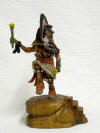 The
Broadface Katsina (Wuyak-kuita) is among the
guards who prevent any transgression on the path of the
Katsinam. Often called the Broadface Whipper Katsina, he carries
yucca fronds that he uses frequently as whips, particularly on
clowns, who are terrified of him. He is an important figure in
the winter Bean Dance (Powamuya) procession. 9"
Native American Hopi Carved Broadface Guard Katsina Doll by
Milton Howard Three size option: 8.5" $900, 11-13"
$1050, 14-16" $2350, 20"-24 $3800 The
Broadface Katsina (Wuyak-kuita) is among the
guards who prevent any transgression on the path of the
Katsinam. Often called the Broadface Whipper Katsina, he carries
yucca fronds that he uses frequently as whips, particularly on
clowns, who are terrified of him. He is an important figure in
the winter Bean Dance (Powamuya) procession. 9"
Native American Hopi Carved Broadface Guard Katsina Doll by
Milton Howard Three size option: 8.5" $900, 11-13"
$1050, 14-16" $2350, 20"-24 $3800
|
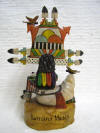 Palhik
Mana is a Butterfly Maiden, not a Katsina, but a woman
dancer. Though at the dances the Butterfly Maiden is not
masked or hooded, she generally appears this way when carved
as a doll. Her tablita(headdress) carries symbols for corn
and butterflies, which pollinate the corn helping to bring a
good harvest. She generally appears in August, as that is
when the butterflies appear. The Butterfly Dance, a
traditional social dance of the Hopi, is held in August
after the gathering of the harvest and presentation of the
Snake Dance. It is a thanksgiving dance for the harvest,
chiefly for the corn crop and features dancing by young Hopi
maidens wearing elaborate headdresses. Native
American Hopi Carved Butterfly Maiden Dancer Katsina Doll by
Milton Howard Three size option: 8.5" $900, 11-13" $1050,
14-16" $2350, 20"-24 $3800 Palhik
Mana is a Butterfly Maiden, not a Katsina, but a woman
dancer. Though at the dances the Butterfly Maiden is not
masked or hooded, she generally appears this way when carved
as a doll. Her tablita(headdress) carries symbols for corn
and butterflies, which pollinate the corn helping to bring a
good harvest. She generally appears in August, as that is
when the butterflies appear. The Butterfly Dance, a
traditional social dance of the Hopi, is held in August
after the gathering of the harvest and presentation of the
Snake Dance. It is a thanksgiving dance for the harvest,
chiefly for the corn crop and features dancing by young Hopi
maidens wearing elaborate headdresses. Native
American Hopi Carved Butterfly Maiden Dancer Katsina Doll by
Milton Howard Three size option: 8.5" $900, 11-13" $1050,
14-16" $2350, 20"-24 $3800
|
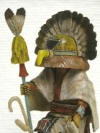 The Ahola is
a Hopi Chief Katsina of very high order. He is considered an
elder and a very wise chief. The Ahola appears at the Bean Dance
(Powamuya) ceremony to open the beginning of the Katsina season.
The Ahola brings prayers for a long and healthful life.
The Ahola and Ahola Mana go from house to house, making their
appearance. On the outside walls of each home, the Ahola draws
four horizontal marks with corn meal. The women inside the house
come out and sprinkle the Ahola with cornmeal and at the same
time take some corn seeds from the Ahola Mana's basket. The two
leave and go to the kiva entrance and face each other. He holds
his staff out for support and strength and bends his right knee
and continues kneeling in rhythmic motion. He calls out to the
kiva chief and the two discuss the arrival of the Kachinam for
the year. Native American Hopi Carved Ahola Chief Katsina Doll
by Milton Howard Three size option: 8.5" $900, 11-13" $1050,
14-16" $2350, 20"-24 $3800 The Ahola is
a Hopi Chief Katsina of very high order. He is considered an
elder and a very wise chief. The Ahola appears at the Bean Dance
(Powamuya) ceremony to open the beginning of the Katsina season.
The Ahola brings prayers for a long and healthful life.
The Ahola and Ahola Mana go from house to house, making their
appearance. On the outside walls of each home, the Ahola draws
four horizontal marks with corn meal. The women inside the house
come out and sprinkle the Ahola with cornmeal and at the same
time take some corn seeds from the Ahola Mana's basket. The two
leave and go to the kiva entrance and face each other. He holds
his staff out for support and strength and bends his right knee
and continues kneeling in rhythmic motion. He calls out to the
kiva chief and the two discuss the arrival of the Kachinam for
the year. Native American Hopi Carved Ahola Chief Katsina Doll
by Milton Howard Three size option: 8.5" $900, 11-13" $1050,
14-16" $2350, 20"-24 $3800
|
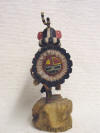 The
Humpback Flute Player (Kokopelli) is an engaging image that
originated in the ancient Paleo-American culture and was brought
into the present by the Pueblo Indians. This classic figure of a
bent over being playing a flute has been associated with
shamanism and supernatural qualities. He is a magical being who,
by playing his flute, calls the clouds to make rain. Today, the
Hopi play flutes over the springs to attract rain. Kokopelli is
also a symbol for fertility because he carries seeds and mist in
his hump. He is mischievous when it comes to seducing young
maidens! The Navajo counterpart to Kokopelli is the Humpback God
who wears mountain sheep horns. His hump, which has eagle
feathers radiating from it contains seeds and mist. He carries a
wand and is called the "God of Mist," "God of Plenty," or the
"God of the Harvest." He is nearly always portrayed with an
image of corn. It is interesting to note that the hump, an
abnormality or deformity, is considered special, even magical
and transformative like fantastic creatures, such as unicorns,
griffins, etc. Shamans are often deformed or have narrowly
escaped physical death.
Native American Hopi Carved Kokopelli Fertility Katsina Doll by
Milton Howard Three size option: 8.5" $900, 11-13" $1050, 14-16"
$2350, 20"-24 $3800 The
Humpback Flute Player (Kokopelli) is an engaging image that
originated in the ancient Paleo-American culture and was brought
into the present by the Pueblo Indians. This classic figure of a
bent over being playing a flute has been associated with
shamanism and supernatural qualities. He is a magical being who,
by playing his flute, calls the clouds to make rain. Today, the
Hopi play flutes over the springs to attract rain. Kokopelli is
also a symbol for fertility because he carries seeds and mist in
his hump. He is mischievous when it comes to seducing young
maidens! The Navajo counterpart to Kokopelli is the Humpback God
who wears mountain sheep horns. His hump, which has eagle
feathers radiating from it contains seeds and mist. He carries a
wand and is called the "God of Mist," "God of Plenty," or the
"God of the Harvest." He is nearly always portrayed with an
image of corn. It is interesting to note that the hump, an
abnormality or deformity, is considered special, even magical
and transformative like fantastic creatures, such as unicorns,
griffins, etc. Shamans are often deformed or have narrowly
escaped physical death.
Native American Hopi Carved Kokopelli Fertility Katsina Doll by
Milton Howard Three size option: 8.5" $900, 11-13" $1050, 14-16"
$2350, 20"-24 $3800
|
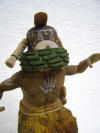 Mastop Katsina
is a Winter Solstice Katsina who is unique to the third Mesa
villages and appears during Soyal ceremony. He is a counterpart
to Second Mesa's Sivaktsina. Both Katsinam represent the energy
of fertility for mankind as well as moisture from rain and snow.
They make copulatory gestures to women to promote the
procreation of life. 9" $950 Native American Hopi
Carved Mastop Fertility Katsina Doll by Murphy Saufkie
BUY NOW Mastop Katsina
is a Winter Solstice Katsina who is unique to the third Mesa
villages and appears during Soyal ceremony. He is a counterpart
to Second Mesa's Sivaktsina. Both Katsinam represent the energy
of fertility for mankind as well as moisture from rain and snow.
They make copulatory gestures to women to promote the
procreation of life. 9" $950 Native American Hopi
Carved Mastop Fertility Katsina Doll by Murphy Saufkie
BUY NOW |
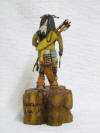 Mountain
Lion (Toho) is accompanied by the Warrior Maiden (He'e'e) and
other guard Katsinam. The Mountain Lion protects the processions
during some ceremonies. In spring ceremonies he appears as a
dancer. Milton does he usual wonderful job on this guard
Katsina. Native American Hopi Carved Mountain Lion
Guard Katsina Doll by Milton Howard Mountain
Lion (Toho) is accompanied by the Warrior Maiden (He'e'e) and
other guard Katsinam. The Mountain Lion protects the processions
during some ceremonies. In spring ceremonies he appears as a
dancer. Milton does he usual wonderful job on this guard
Katsina. Native American Hopi Carved Mountain Lion
Guard Katsina Doll by Milton Howard
Three size option: 8.5" $900, 11-13" $1050, 14-16" $2350,
20"-24 $3800
|
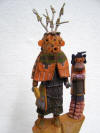 Maasaw, also
written as Masauwu or Masau, is known as the Hopi Death Katsina
and as Creator. He is responsible for the Earth's surface, fire,
and the underworld. Death was an important part of hunting and
war, and hunters, warriors, and shamen called upon him for
assistance. Hunters sought food, and called upon Maasaw to guide
the spirit of the animal into the underworld where it could
enter the cycle of rebirth. Warriors sought the death of their
enemy or power for battle. Shamen sought to heal the sick, since
Maasaw had power over death. Maasaw Mana is the maiden who
accompanies Maasaw. She appears at Angk’wa, Summer Day Dances
and after Niman. She represents protection and guidance, rain
and bountiful harvest. When she appears at the dance with Maasaw
it is to keep in check his omniscient power. This is one of the
very few Katsinam personated by a woman (most are men dressed as
women). This particular set of carvings was done from one piece
of wood that had a split down the center. John cut the wood in
half and carved the two Katsinam. This is a spectacular pair of
these powerful Katsinam. $850 17" & 13" Tall
Native American Hopi Carved Maasaw and Maasaw Mana Katsina Dolls
by John Fredericks
BUY NOW Maasaw, also
written as Masauwu or Masau, is known as the Hopi Death Katsina
and as Creator. He is responsible for the Earth's surface, fire,
and the underworld. Death was an important part of hunting and
war, and hunters, warriors, and shamen called upon him for
assistance. Hunters sought food, and called upon Maasaw to guide
the spirit of the animal into the underworld where it could
enter the cycle of rebirth. Warriors sought the death of their
enemy or power for battle. Shamen sought to heal the sick, since
Maasaw had power over death. Maasaw Mana is the maiden who
accompanies Maasaw. She appears at Angk’wa, Summer Day Dances
and after Niman. She represents protection and guidance, rain
and bountiful harvest. When she appears at the dance with Maasaw
it is to keep in check his omniscient power. This is one of the
very few Katsinam personated by a woman (most are men dressed as
women). This particular set of carvings was done from one piece
of wood that had a split down the center. John cut the wood in
half and carved the two Katsinam. This is a spectacular pair of
these powerful Katsinam. $850 17" & 13" Tall
Native American Hopi Carved Maasaw and Maasaw Mana Katsina Dolls
by John Fredericks
BUY NOW |
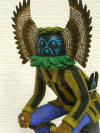 Qoqooqlo (Qoqole or Qooqoqlo)
appears only at Third Mesa during Soyal. He tells stories and
prophesies good crops. He brings gifts for the children and
combines ritual with pleasure. One moment Qoqooqlo will be
marking the four sides of the Kivas to allow the other Katsinam
to come and visit the village and the next moment he may be
kneeling on the ground shooting marbles. Henry Naha did a
wonderful job on this Katsina 9.5" $950
Native American Hopi Carved Qoqooqlo Storyteller Katsina Doll by
Henry Naha
BUY NOW Qoqooqlo (Qoqole or Qooqoqlo)
appears only at Third Mesa during Soyal. He tells stories and
prophesies good crops. He brings gifts for the children and
combines ritual with pleasure. One moment Qoqooqlo will be
marking the four sides of the Kivas to allow the other Katsinam
to come and visit the village and the next moment he may be
kneeling on the ground shooting marbles. Henry Naha did a
wonderful job on this Katsina 9.5" $950
Native American Hopi Carved Qoqooqlo Storyteller Katsina Doll by
Henry Naha
BUY NOW |
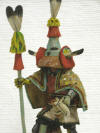 Aholi is
a Native American Hopi high priest who appears only on Third
Mesa and in the company of Eototo during the Powamuya Ceremony.
This Katsina is the ancient of the Pikyas Clan. Legend has it
that Aholi, left behind to fight a rear guard action, followed
Eototo through migrations that took them from Mexico to Utah and
from the Colorado River to the City Rio Grande and back to their
present location on Third Mesa. The two Katsinam come out of the
Chief Kiva during Powamuya and perform the rites described under
Eototo. Aholi is a beautiful Katsina in his cloak and tall blue
helmet, but he is of less importance than the very plain Eototo
and is often called Eototo's Lieutenant. When Eototo places his
cloud mark on the ground, Aholi puts the butt of his staff upon
it and swinging the staff around calls out, "A--holi-i-i-i" and
then follows his chief to the next mark. His actions appear to
be a reinforcing of Eototo's actions. Three size option: 8.5"
$900, 11-13" $1050, 14-16" $2350, 20"-24 $3800 Native
American Hopi Carved Aholi Priest Katsina Doll by Milton Howard Aholi is
a Native American Hopi high priest who appears only on Third
Mesa and in the company of Eototo during the Powamuya Ceremony.
This Katsina is the ancient of the Pikyas Clan. Legend has it
that Aholi, left behind to fight a rear guard action, followed
Eototo through migrations that took them from Mexico to Utah and
from the Colorado River to the City Rio Grande and back to their
present location on Third Mesa. The two Katsinam come out of the
Chief Kiva during Powamuya and perform the rites described under
Eototo. Aholi is a beautiful Katsina in his cloak and tall blue
helmet, but he is of less importance than the very plain Eototo
and is often called Eototo's Lieutenant. When Eototo places his
cloud mark on the ground, Aholi puts the butt of his staff upon
it and swinging the staff around calls out, "A--holi-i-i-i" and
then follows his chief to the next mark. His actions appear to
be a reinforcing of Eototo's actions. Three size option: 8.5"
$900, 11-13" $1050, 14-16" $2350, 20"-24 $3800 Native
American Hopi Carved Aholi Priest Katsina Doll by Milton Howard |
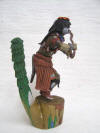 Snake
Dancer Katsinamm (Chusona) appear at late summer dances. Chusona
is said to dance with a snake in his mouth. Because his
appearance at the dance attracted many non-natives and reactions
to him were often inappropriate, the dance is closed to
non-natives. Chusona is mistakenly taken for a Katsina. He is
not, being rather a society personage, but one of great
popularity. The Snake Dance has always had an intense
fascination for the non-Hopi, and in consequence effigies of
this personage have been carved for many years. This Snake
Dancer has an additional carving of the Snake House, this is
where the snakes are held in ceramic urns before and during the
ceremony. The dancers enter the Snake House to retrieve the
snakes for the dance. 11.5" $950
Native American Hopi Carved Snake Dancer Katsina Doll with Snake
House by John Fredericks
BUY NOW Snake
Dancer Katsinamm (Chusona) appear at late summer dances. Chusona
is said to dance with a snake in his mouth. Because his
appearance at the dance attracted many non-natives and reactions
to him were often inappropriate, the dance is closed to
non-natives. Chusona is mistakenly taken for a Katsina. He is
not, being rather a society personage, but one of great
popularity. The Snake Dance has always had an intense
fascination for the non-Hopi, and in consequence effigies of
this personage have been carved for many years. This Snake
Dancer has an additional carving of the Snake House, this is
where the snakes are held in ceramic urns before and during the
ceremony. The dancers enter the Snake House to retrieve the
snakes for the dance. 11.5" $950
Native American Hopi Carved Snake Dancer Katsina Doll with Snake
House by John Fredericks
BUY NOW |
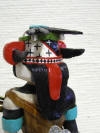 This
Warrior (Ewiro) appears during Pachavu and later, in Plaza
Dances, he makes war on the clowns. He functions as a policeman
and oversees the cleaning of the springs. Chester Beard did a
wonderful job on this Ewiro 11" $900
Native American Hopi Carved Wildcat Angry Katsina
Doll by Alexander Youvella Sr.
BUY NOW This
Warrior (Ewiro) appears during Pachavu and later, in Plaza
Dances, he makes war on the clowns. He functions as a policeman
and oversees the cleaning of the springs. Chester Beard did a
wonderful job on this Ewiro 11" $900
Native American Hopi Carved Wildcat Angry Katsina
Doll by Alexander Youvella Sr.
BUY NOW |
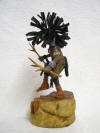 The
Wind (Yaponcha) is not a Katsina but is a being or myth meant to
scare the children. He is disliked and when he appears, which is
rarely, people throw stones at him to try to get him to leave so
the wind will stop blowing. In the male form he frightens the
girls into good behavior; in the female form he frightens the
boys into good behavior. Native American
Hopi Carved Wind Deity Katsina Doll by Milton Howard The
Wind (Yaponcha) is not a Katsina but is a being or myth meant to
scare the children. He is disliked and when he appears, which is
rarely, people throw stones at him to try to get him to leave so
the wind will stop blowing. In the male form he frightens the
girls into good behavior; in the female form he frightens the
boys into good behavior. Native American
Hopi Carved Wind Deity Katsina Doll by Milton Howard
Three size option: 8.5" $900, 11-13" $1050, 14-16" $2350, 20"-24
$3800
|
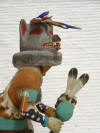 The
Wolf (Kweo) is often seen in the Soyohim Dances accompanied by
the Deer or Mountain Sheep Katsina. He carries a stick that
represents the trees and bushes that he uses to hide in whenever
he stalks his prey. The Wolf Katsina's sharp teeth are always
visible and, sometimes, his lolling tongue. His sharp teeth are
visible to boast the wolf's prowess as a hunter. When he appears
in the dance with the Deer or Mountain Sheep, they are always
wary of him because of their natural relationship as prey for
the Wolf. After the dance, it is customary for the Hopi to offer
the Kweo Katsina cornmeal and, in return, the Kweo Katsina
blesses them on their hunt. Silas carved this Wolf out of a
single piece of wood. A remarkable carving for him since he
suffers with crippling arthritis.
10" Native American Hopi Carved Wolf Hunter Katsina Doll by
Silas Roy $950 BUY NOW The
Wolf (Kweo) is often seen in the Soyohim Dances accompanied by
the Deer or Mountain Sheep Katsina. He carries a stick that
represents the trees and bushes that he uses to hide in whenever
he stalks his prey. The Wolf Katsina's sharp teeth are always
visible and, sometimes, his lolling tongue. His sharp teeth are
visible to boast the wolf's prowess as a hunter. When he appears
in the dance with the Deer or Mountain Sheep, they are always
wary of him because of their natural relationship as prey for
the Wolf. After the dance, it is customary for the Hopi to offer
the Kweo Katsina cornmeal and, in return, the Kweo Katsina
blesses them on their hunt. Silas carved this Wolf out of a
single piece of wood. A remarkable carving for him since he
suffers with crippling arthritis.
10" Native American Hopi Carved Wolf Hunter Katsina Doll by
Silas Roy $950 BUY NOW |
|
TOP |
|
|
Navajo Kachinas
Sammie Walker Kachinas
Hopi Full Figure Kachinas
Hopi Miniature Kachinas
Hopi Sculpture Katsina
Hopi Old World Style
Kachina
Zuni Fetish
|
KACHINA OF THE MONTH CLUB
Save by ordering
a monthly Kachina
(Three month minimum) |
|
|
|
|
|
|
 |
Top Sellers
|
. |
|
|
 |
Store Categories
|
|
|
NATIVE AMERICAN
Kachinas
Zuni Fetish
Pottery
Artifacts
Drums
Baskets
Gourd Art
Alaska Carvings
Christmas Ornaments
|
| |
|






